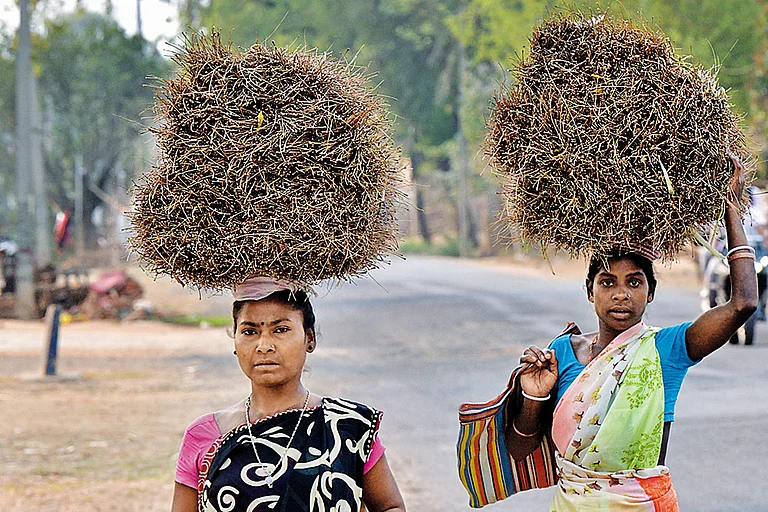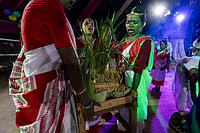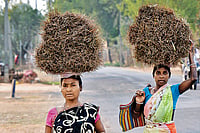Aare-Keram, a village 25 km from Jharkhand’s capital Ranchi, is a perfect example of a turnaround story. The stunning dense forest that surrounds the village was so sparse not very long ago that it could not hide even a small animal. It has now grown thick enough that a beast as large as an elephant passes through it undetected.
The credit goes to the villagers who have worked hard since 1992 to save their forest. Since 2005, they have been protecting their water, forest, and land under the Forest Conservation and Management Committee.
Since 2015, there has been a complete ban on felling trees in the forest. Both men and women from the village guard the forest. If people from other villages are caught cutting trees or even collecting leaves from the forest, they are fined. There is also a ban on the use of plastic in the village. Once every week, the happenings in this 400-acre forest are reported in the Gram Sabha meeting. One of the things that make the Gram Sabha meetings of Aara-Keram special is the participation of children in them.
The traditional knowledge of the tribals and their collectivism has wrought a change in the village that has become an example for the country. Since 2017, there is a ban on individual boring in this village with about 150 houses. Currently, they meet their need for water from eight to ten government hand pumps and wells.
In 2019, 200 men and women of the village donated their labour for 70 days to build 700 loose structures of boulders to divert the rainwater flowing down the mountains to the fields, rivers, ponds, and wells. This enables the runoff from the mountains to be pooled and used throughout the year. At present, there is water available around the year in 72 dobhas (small ponds), 55 wells, and four big ponds in the village. Thus, the village escapes the clutches of the frequent droughts that afflict the rest of the state, and its agriculture prospers.
The village head, Ramesh Bedia, talks about how the dense forest keeps the environment of his village balanced. He says, “Even on summer nights, the villagers sleep with a thick blanket. Nature is the source of all things for us. The trees are our oxygen factory. If we do not save them, we cannot survive even with all the wealth in the world.”
Water, forest, and land are very important in the daily life of the tribal society, which worships nature. The village of Aara-Keram was praised by Prime Minister Narendra Modi in his Mann Ki Baat radio address for prioritising the conservation of these three aspects of the immediate environment.
Hundreds of villages like Aara-Keram still exist in Jharkhand, where people have been saving nature and the environment for several long years. Hariyarpur Jamtoli Panchayat of Bero Bazaar, 45 km from Ranchi, is known for Simon Oraon. Dubbed “Jharkhand's Waterman”, Oraon has dedicated his entire life to saving nature and the environment. He was awarded the Padma Shri in 2016 for his services.
Now 89, Oraon toiled with other villagers to plant thousands of trees and build ponds, dams, and reservoirs. The water from the mountains was collected in them, to be supplied to the fields. Then using motor pumps, this water was lifted and taken to the wells and from there onwards to the fields. As a result of all this collective toil, the villages of Hariyarpur Jamtoli, Khaksi Toli, Bartoli, Harhanji, Khurahatoli, and Bhansananda, all grow three crops and vegetables through the year, where once they had hardly one crop in a year. For the people of these villages, conservation of the environment is as essential as food for their survival.
In recent years, there has been a growing recognition in the climate change discourse that the tribals and their traditional way of life are important for the conservation of the environment. Of the greenhouse gases, carbon dioxide is released the most into the atmosphere, contributing majorly to climate change. A tree absorbs about 25 kilograms of carbon dioxide every year.
So, trees have a very important role to play in our fight against climate change. Jharkhand is called the state of forests. In the forest-adjacent villages where the tribals live, the sakhua or sal tree grows most abundantly and is revered by the tribals. Trees are worshipped during the Sarhul and Karma festivals, which also shows the tribals’ attachment to nature.
It is said that when there was nothing else to eat and wear, the tribals ate the sal fruits and made clothes out of the sal leaves. The sal leaf is quite unique in that if it is plucked from its petiole or stalk and placed in water, it remains alive for a long time. It does not rot. A famous saying about the tree has is that it stands for a thousand years, lies on the ground for another thousand years, yet it does not perish (“Hazaar saal khada, hazaar saal para, phir bhi nahin sada”).
The sal tree produces a cooling effect on the environment. Environmentalists explain that these trees grow very tall and bear leaves during a large part of the year. This results in large amounts of transpiration. When the monsoon arrives, the trees attract the clouds, causing rain.
There is an abundance of sal trees in the forests of Jharkhand. The Saranda forest that spreads over 82,000 hectares in the district of West Singhbhum is known as the densest sal forest in Asia.
Author and activist Gladson Dungdung believes that the tribals function as a protective shield for the forests and that the government and all the tribal-dominated states will have to understand this fact and factor it into their policies. A system to prevent and fight climate change is built into the life philosophy of the tribals, he says.
Dungdung continues: “The tribals believe in a needs-based economy. For instance, they know that dry wood cannot be found during the rainy season, so they collect it in advance to meet their needs for three months. Others in this situation would collect wood for 10 years. Apart from agriculture, the tribals meet their yearly expenses by selling forest produce. Every family earns Rs 2-2.5 lakh by selling lac and mahua. They eat pithor, mango, jamun, bahara, bael, and peor, which grow in the forest.”
Dungdung says that for the rest of the world, coexistence implies people of all castes live together, but the tribals talk about living with animals, forests, and insects, as well as humans. He says that the tribals are in sync with nature's system, so they do not depend on external things.
According to a report by the Tribal Ministry of the Government of India, there are dense forests in 215 tribal-dominated districts in 27 states. The report also contradicts the claim advanced by a 1976 report by the Agriculture Commission that forests are depleting around tribal inhabitations.
Today, the whole world looks to the traditional lifestyle of the tribals as a way to overcome climate change. Archana Soreng, hailing from the Sundargarh district of Odisha, has been connected to the land and forests since childhood.
Salso took them up as the subject of her further studies. In 2020, she was included in the Advisory Group on Climate Change by the United Nations Chief. Soreng had then said in a statement that the tribals have a judicious sense of the amounts of forest produce that can be taken by humans and the best spots to take it from, so that the balance of the forest is maintained.
She said, “Tribal customs and culture are the path to conserving the environment and saving the world from the worsening climate crisis. To the tribals, forests and nature are their life and identity, whereas for others, nature is just business.”
(Translated by Kaushika Draavid)












.jpg?auto=format%2Ccompress&fit=max&format=webp&w=768&dpr=1.0)
















